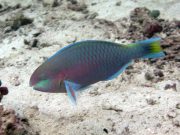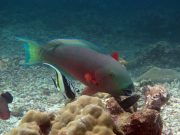Dykning med Papegojfiskar
Lanta Marina Liv | Scaridae
Papegojfiskar är nära besläktade med läppfiskfamiljen och med cirka 95 arter är de en av de vanligaste och viktigaste fiskarna i korallreven. De ses regelbundet i alla korallrev när man dyker runt Koh Lanta.
Papegojfiskar har trubbiga huvuden och djupa kroppar och är lätta att känna igen på de tätt packade tänderna på utsidan av käkbenen, som bildar en papegojliknande näbb som används för att skrapa alger och tång från koraller och andra steniga ytor.
Tänderna växer kontinuerligt och ersätter material som slits bort genom födointaget. Bitar av sten eller korall som äts tillsammans med algerna krossas till sand och mals tillsammans med algerna för att underlätta matsmältningen, vilket gör papegojfiskar till några av de viktigaste producenterna av sand på korallreven. Papegojfiskars avföring består oftast av sand.


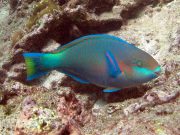
Forskare uppskattar att en enda stor papegojfisk kan producera nästan 1 000 kg sand varje år!
Denna ständiga rengöring av revet är avgörande för friska koraller och ett blomstrande rev.
Papegojfiskar lever i allmänhet i cirka 5 till 7 år. Ungfiskar av de flesta arter börjar livet som honor, ofta med en matt röd, brun eller grå kroppsfärg.
Unga papegojfiskar bildar harem, där den största honan byter kön till hane, liksom deras nära släktingar, läppfiskar och clownfiskar. Förvandlingen från hona till hane åtföljs vanligtvis av en dramatisk förändring av kroppsfärgen till ljusgrön eller blå med livfulla röda, rosa, orange eller gula fläckar.
Ibland kan stora stim med många hundra individer bildas, som rör sig runt revet i tätt packade grupper och dyker ner över korallerna för att äta av algbäddar.
På samma sätt som människor bär pyjamas när de går och lägger sig, kan papegojfiskar producera en slemkokong på natten, som de blåser ut ur munnen och täcker hela kroppen med medan de sover.
Marinbiologer tror att denna slemkokong döljer deras doft från nattliga rovdjur som muränor.
Papegojfiskar finns på alla dykplatser runt Koh Lanta, där de ständigt patrullerar revet och letar efter alger och koraller att äta.
9 arter finns på denna sida:
- Redlip Parrotfish (Scarus rubroviolaceus)
- Swarthy Parrotfish (Scarus niger)
- Greenlip Parrotfish (Scarus virdifucatus)
- Greenthroat Parrotfish (Scarus prasiognathos)
- Indian Parrotfish (Chlorurus capistratoides)
- Roundhead Parrotfish (Chlorurus strongylocephalus)
- Bullethead Parrotfish (Chlorurus sordidus)
- Greenhead Parrotfish (Chlorurus troschelii)
- Bicolour Parrotfish (Cetoscarus ocellatus)
Redlip Parrotfish
(Scarus rubroviolaceus)
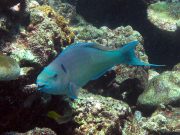
Scarus rubroviolaceus @ Koh Bida
The male (Terminal Phase) Redlip Parrotfish has a green body colour, often bicolour, with a darker forebody. There is a green to blue band on the upper lip and double bands on the chin. There are many blue and green stripes on the tail.
Female (Initial Phase) Redlip Parrotfish have a dark body, with shades of reddish brown to grey. There are small black spots on the body, and possibly wavy lines on the scales.The fins and lips are often red.
The Redlip Parrotfish grows to 70 cm. Females are frequently seen with large males.
Swarthy Parrotfish
(Scarus niger)
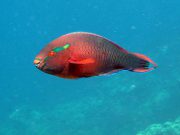
Scarus niger @ Koh Bida
The male Swarthy Parrotfish is a dark reddish brown colour, greenish toward the rear, taking on a more purplish-green colour as it grows. The lips are red and there is a yellow to green spot or streak behind the eye. There are dark bands around the mouth. The tail fin has elongated lobes.
Female Swarthy Parrotfish have a red head and dark main body with many black and white horizontal wavy lines. There are dark bands around the mouth, and a dark spot or stripe close to, or through the eye. The tail fin is rounded.
The Swarthy Parrotfish grows to 35 cm and is found in coral rich areas. Feeds on bottom dwelling algae.
Greenlip Parrotfish
(Scarus virdifucatus)

Scarus virdifucatus @ Koh Haa
The male Greenlip Parrotfish has a greenish purple body and purple head. The body green scales have a purple border. The cheek is blue-green in colour and there are a series of variable, wavy markings behind the mouth.
The dorsal, anal and tail fins have blue margins. The tail fin is rounded with a yellowish center.
The female Greenlip Parrotfish is dark brown.
The Greenlip Parrotfish grows to 32 cm and feeds on bottom dwelling algae.
Greenthroat Parrotfish
(Scarus prasiognathos)
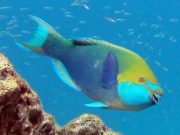
Scarus prasiognathos @ Koh Haa
The male Greenthroat Parrotfish, also known as the Singapore parrotfish, has a dark green body with a yellowish upper head. The lower head is green, and there is a broad green band across the snout.
The female Greenthroat Parrotfish has a reddish brown body with some scattered white spots. The head is often lighter than the body.
The male Greenthroat Parrotfish grows to 70 cm, often form large feeding schools along the reef, overwhelming the defences of other territorial species. Females grow to 40 cm.
Indian Parrotfish
(Chlorurus capistratoides)

Female (IP) Chlorurus capistratoides @ Koh Haa
Male (Terminal Phase) Indian Parrotfish have a green back with a rosy pink streak on each scale. The pectoral region is yellow and there are green bands around the mouth and eyes.
Juvenile (female, Initial Phase) Indian Parrotfish are dark grey with a pale pinkish snout and tail and 4 - 5 whitish bars of varying intensity. The pectoral fin is pinkish with a yellow outer margin to the rear.
The Indian Parrotfish grows to 55 cm and forms large feeding schools of mostly females, with a smaller number of males following behind the feeding frenzy.
Roundhead Parrotfish
(Chlorurus strongylocephalus)
The Male Roundhead Parrotfish, also known as the Indian Ocean Steephead Parrotfish, has a steep forehead, a blue to green body, and an extensive yellow-green area on the cheek. The tail fin is dark blue, with lighter margins and elongated tail fin lobes.

Male Chlorurus strongycephalus @ Koh Haa
Female Roundhead Parrotfish have a yellow green upper head, back and tail. The body is predominantly reddish to reddish brown. There are dark green markings around the mouth, and there are blue-green margins on the tail fin.
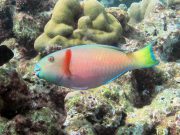
Female Chlorurus strongycephalus @ Koh Haa
The species complex comprises the the Roundhead Parrotfish (Chlorurus strongylocephalus) in the Indian Ocean, the Steephead Parrotfish (Chlorurus microrhinos) in the west-central Pacific, and the Heavybeak Parrotfish (Chlorurus gibbus) in the Red Sea.
The Roundhead Parrotfish grows to 70 cm and is often seen solitary, or with several females. The diet consists of algae and this species is usually seen around the reef edge.
Bullethead Parrotfish
(Chlorurus sordidus)
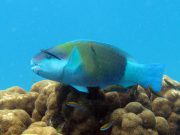
Terminal Phase (male) Chlorurus sordidus @ Koh Haa
Male (Terminal Phase) Bullethead Parrotfish, also known as the Greenfin Parrotfish, has a generally green body, some variations with lavender scale edges.
There are variously coloured markings and patches on the head, often yellowish, blue, green and lavender. All colourations have a pale green tail base and a square-cut tail fin. The snout is rounded.
Female (juvenile, Initial Phase) Bullethead Parrotfish have a light reddish brown head and forebody, with a darker mid and rear body.
Older juveniles will have a dark tail with 3 or 4 vertical rows of white spots, and younger juveniles will have a white tail fin and tail fin base, with a large dark spot on the tail fin base.
Bullethead Parrotfish can grow to 40 cm, and feed on bottom dwelling algae. Juveniles and individuals in the initial phase can form large schools which migrate great distances between feeding and sleeping grounds.
Greenhead Parrotfish
(Chlorurus troschelii)

Chlorurus troschelii @ Koh Haa
The adult (male, Terminal Phase) Greenhead Parrotfish, also known as Troschel's parrotfish has a green body with pink to lavender scale edges gradating to blush on lower body.
The upper head is green, and there is a large pale patch on the cheek which extends to the lower head. There is a dark band from the corner of the mouth through the eye.
Juveniles (females, Initial Phase) have a dark grey-brown to black body, with three to four pale yellow bars.
The adult Greenhead Parrotfish grows to 35 cm and can be found in areas with high coral cover.
Bicolour Parrotfish
(Cetoscarus ocellatus)
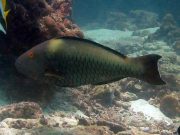
Female Cetoscarus ocellatus @ Koh Haa
Male (Terminal Phase) Bicolour Parrotfish grow to 80 cm and are green with pinkish red spots and lines on the head and a pinkish line from the mouth to the belly.
The larger body scale margins are pinkish and there are also pinkish bands and streaks on the fins.
Female (Initial Phase) Bicolour Parrotfish have a dark head and greenish body, with dark green scale margins and a lighter green back. The iris is orange.
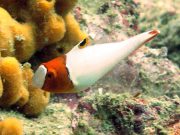
Juvenile Cetoscarus ocellatus @ Koh Haa
Juvenile Bicolour Parrotfish have a white body, with a thick orange band around the head, a black ocellated spot with a yellow margin on the dorsal fin and broad orange submarginal band on the tail.
Dykning med Papegojfiskar runt Koh Lanta
Dykning och Snorkelutflykter
Om du vill ha en chans att se Papegojfiskar på en av våra dagliga högsäsongs dykresor från Koh Lanta, skicka oss ett e-postmeddelande till info@diveandrelax.com.
Följ med på våra dykresor med speedboat under högsäsong till några av Thailands bästa dykplatser och njut av små grupper, korta restider och fokus på personlig service, säkerhet och nöje.
Är du ännu inte certifierad dykare? Lär dig att dyka på Koh Lanta med den 3-dagars SSI Open Water Diver-kursen.
Boka online och spara 10 % på dykresor och dykkurser på Koh Lanta.
Ta Reda på Mer
Guider för Marina Djur och Växter i Indo-Stilla Havet
- Allen, G., Steene, R., Humann, P., DeLoach, N. (2003) Reef Fish Identification, Tropical Pacific. Jacksonville, FL., USA: New World Publications, Inc., ISBN 1-878348-36-1.
- Humann, P., DeLoach, N., (2010) Reef Creature Identification, Tropical Pacific. Jacksonville, FL., USA: New World Publications Inc., ISBN 978-1-878348-44-9
- Debelius, H. (2013) Indian Ocean Reef Guide. Frankfurt, Germany: IKAN - Unterwasserarchiv, ISBN 978-3-939767-52-7.
- Debelius, H. (2004) Nudibranchs and Sea Snails, Indo-Pacific Field Guide. Frankfurt, Germany: IKAN - Unterwasserarchiv, ISBN 3-925919-51-1
- Erhardt, H., Knop, D. (2015) Corals Indo-Pacific Field Guide. Frankfurt, Germany: IKAN - Unterwasserarchiv, ISBN 3-925919-69-4.
- Veron J.E.N., Stafford-Smith M.G., Turak E. and DeVantier L.M. (2016). Corals of the World


